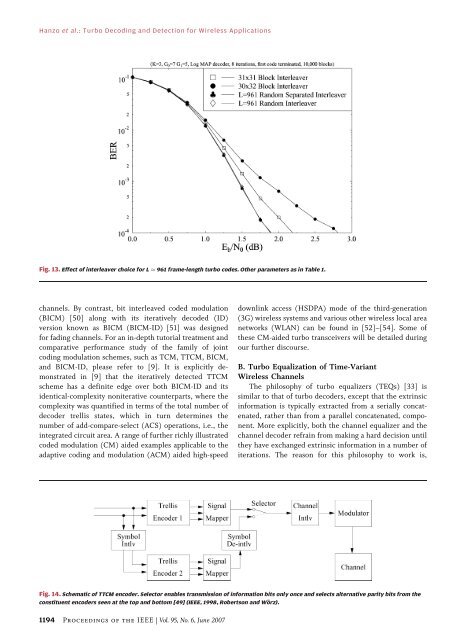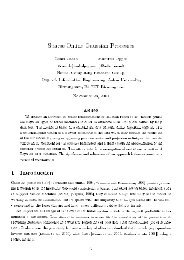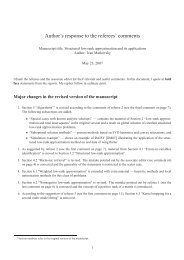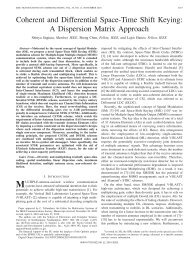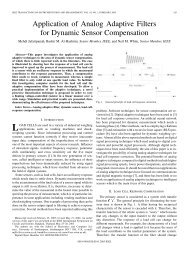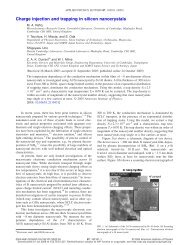Turbo Decoding and Detection for Wireless Applications
Turbo Decoding and Detection for Wireless Applications
Turbo Decoding and Detection for Wireless Applications
You also want an ePaper? Increase the reach of your titles
YUMPU automatically turns print PDFs into web optimized ePapers that Google loves.
Hanzo et al.: <strong>Turbo</strong> <strong>Decoding</strong> <strong>and</strong> <strong>Detection</strong> <strong>for</strong> <strong>Wireless</strong> <strong>Applications</strong><br />
Fig. 13. Effect of interleaver choice <strong>for</strong> L 961 frame-length turbo codes. Other parameters as in Table 1.<br />
channels. By contrast, bit interleaved coded modulation<br />
(BICM) [50] along with its iteratively decoded (ID)<br />
version known as BICM (BICM-ID) [51] was designed<br />
<strong>for</strong> fading channels. For an in-depth tutorial treatment <strong>and</strong><br />
comparative per<strong>for</strong>mance study of the family of joint<br />
coding modulation schemes, such as TCM, TTCM, BICM,<br />
<strong>and</strong> BICM-ID, please refer to [9]. It is explicitly demonstrated<br />
in [9] that the iteratively detected TTCM<br />
scheme has a definite edge over both BICM-ID <strong>and</strong> its<br />
identical-complexity noniterative counterparts, where the<br />
complexity was quantified in terms of the total number of<br />
decoder trellis states, which in turn determines the<br />
number of add-compare-select (ACS) operations, i.e., the<br />
integrated circuit area. A range of further richly illustrated<br />
coded modulation (CM) aided examples applicable to the<br />
adaptive coding <strong>and</strong> modulation (ACM) aided high-speed<br />
downlink access (HSDPA) mode of the third-generation<br />
(3G) wireless systems <strong>and</strong> various other wireless local area<br />
networks (WLAN) can be found in [52]–[54]. Some of<br />
these CM-aided turbo transceivers will be detailed during<br />
our further discourse.<br />
B. <strong>Turbo</strong> Equalization of Time-Variant<br />
<strong>Wireless</strong> Channels<br />
The philosophy of turbo equalizers (TEQs) [33] is<br />
similar to that of turbo decoders, except that the extrinsic<br />
in<strong>for</strong>mation is typically extracted from a serially concatenated,<br />
rather than from a parallel concatenated, component.<br />
More explicitly, both the channel equalizer <strong>and</strong> the<br />
channel decoder refrain from making a hard decision until<br />
they have exchanged extrinsic in<strong>for</strong>mation in a number of<br />
iterations. The reason <strong>for</strong> this philosophy to work is,<br />
Fig. 14. Schematic of TTCM encoder. Selector enables transmission of in<strong>for</strong>mation bits only once <strong>and</strong> selects alternative parity bits from the<br />
constituent encoders seen at the top <strong>and</strong> bottom [49] (IEEE, 1998, Robertson <strong>and</strong> Wörz).<br />
1194 Proceedings of the IEEE |Vol.95,No.6,June2007


